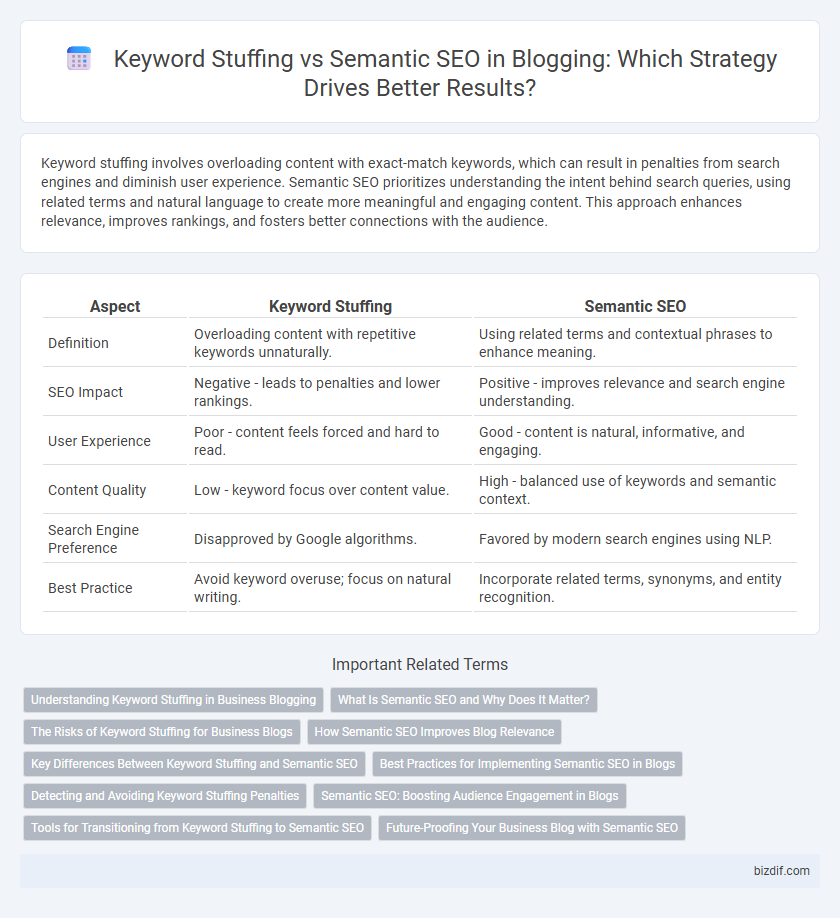Keyword stuffing involves overloading content with exact-match keywords, which can result in penalties from search engines and diminish user experience. Semantic SEO prioritizes understanding the intent behind search queries, using related terms and natural language to create more meaningful and engaging content. This approach enhances relevance, improves rankings, and fosters better connections with the audience.
Table of Comparison
| Aspect | Keyword Stuffing | Semantic SEO |
|---|---|---|
| Definition | Overloading content with repetitive keywords unnaturally. | Using related terms and contextual phrases to enhance meaning. |
| SEO Impact | Negative - leads to penalties and lower rankings. | Positive - improves relevance and search engine understanding. |
| User Experience | Poor - content feels forced and hard to read. | Good - content is natural, informative, and engaging. |
| Content Quality | Low - keyword focus over content value. | High - balanced use of keywords and semantic context. |
| Search Engine Preference | Disapproved by Google algorithms. | Favored by modern search engines using NLP. |
| Best Practice | Avoid keyword overuse; focus on natural writing. | Incorporate related terms, synonyms, and entity recognition. |
Understanding Keyword Stuffing in Business Blogging
Keyword stuffing in business blogging involves the excessive and unnatural repetition of keywords to manipulate search engine rankings, which can lead to penalties and reduce user experience. Semantic SEO focuses on creating content that addresses related topics and user intent by using meaningful phrases and contextually relevant terms. Understanding the drawbacks of keyword stuffing helps businesses prioritize semantic SEO strategies that improve organic traffic and enhance content relevance.
What Is Semantic SEO and Why Does It Matter?
Semantic SEO involves optimizing content with related concepts and entities to improve search engine understanding and relevance, moving beyond simple keyword frequency. It enhances user experience by addressing search intent and providing comprehensive answers, increasing the content's visibility and ranking potential. This approach matters because search algorithms prioritize context and meaning, making semantic SEO essential for effective blogging strategies.
The Risks of Keyword Stuffing for Business Blogs
Keyword stuffing in business blogs can severely damage search engine rankings and user experience by triggering penalties from algorithms like Google's Panda and Penguin. Overloading content with excessive keywords reduces readability and trust, driving away potential customers and increasing bounce rates. Adopting Semantic SEO strategies improves content relevance and engagement by naturally incorporating related terms and user intent, fostering sustainable organic traffic growth.
How Semantic SEO Improves Blog Relevance
Semantic SEO improves blog relevance by focusing on topic intent and user context rather than repeated keyword usage, resulting in content that better matches search queries. It enhances natural language understanding through the use of related terms, synonyms, and structured data, increasing the chances of higher search engine rankings. This approach avoids keyword stuffing penalties while delivering valuable, context-rich content that engages readers and improves overall blog authority.
Key Differences Between Keyword Stuffing and Semantic SEO
Keyword stuffing involves overloading a blog post with repetitive keywords, which can lead to poor readability and search engine penalties. Semantic SEO focuses on natural language usage, context, and related concepts to improve content relevance and user experience. This approach enhances search engine understanding by leveraging Latent Semantic Indexing (LSI) and entity-based optimization for better ranking.
Best Practices for Implementing Semantic SEO in Blogs
Effective semantic SEO in blogs prioritizes natural language and contextually relevant keywords over keyword stuffing, which can harm readability and search rankings. Implementing structured data, latent semantic indexing (LSI) keywords, and comprehensive topic coverage enhances content relevance and user experience. Leveraging tools like Google's Natural Language API and ensuring content answers user intent are best practices to optimize semantic SEO and improve organic visibility.
Detecting and Avoiding Keyword Stuffing Penalties
Detecting keyword stuffing involves analyzing content for unnatural keyword density and repetitive phrases that disrupt user experience and trigger search engine penalties. Avoiding such penalties requires integrating semantic SEO techniques like using related terms, synonyms, and contextually relevant phrases to create meaningful, user-focused content. Employing tools like Google Search Console and SEMrush can help identify keyword overuse and optimize content without compromising its semantic richness.
Semantic SEO: Boosting Audience Engagement in Blogs
Semantic SEO enhances blog content by using contextually relevant keywords and natural language patterns, improving search engine understanding and user experience. This approach encourages higher audience engagement through meaningful, informative posts that answer specific queries and foster trust. Unlike keyword stuffing, Semantic SEO drives organic traffic growth and longer visit durations by aligning content with user intent.
Tools for Transitioning from Keyword Stuffing to Semantic SEO
Tools like Clearscope, Surfer SEO, and MarketMuse help bloggers transition from keyword stuffing to semantic SEO by analyzing content relevance, keyword context, and user intent. These platforms utilize natural language processing to identify topic clusters and related terms, improving content quality and search engine rankings. Implementing such tools increases organic traffic by aligning content with Google's evolving algorithms focused on semantic understanding.
Future-Proofing Your Business Blog with Semantic SEO
Keyword stuffing can harm search rankings and degrade user experience by overloading content with repetitive phrases, making the blog appear spammy. Semantic SEO leverages contextual relevance and natural language processing to enhance content quality, ensuring better alignment with search intent and improved rankings. Future-proofing your business blog requires adopting Semantic SEO strategies that prioritize meaningful, user-focused content and adaptable algorithm resilience.
Keyword stuffing vs Semantic SEO Infographic

 bizdif.com
bizdif.com